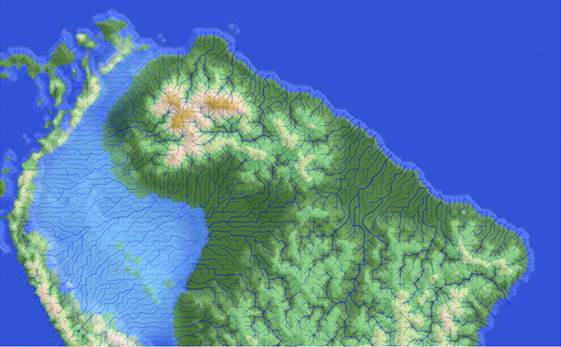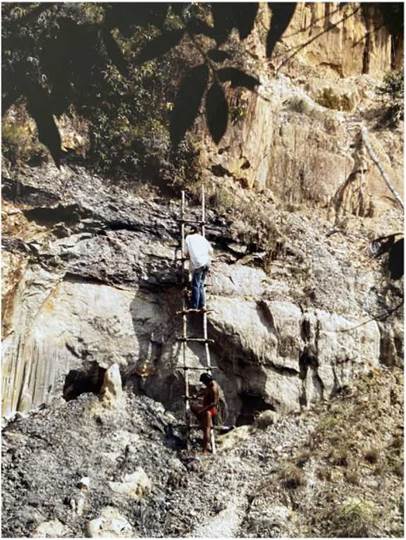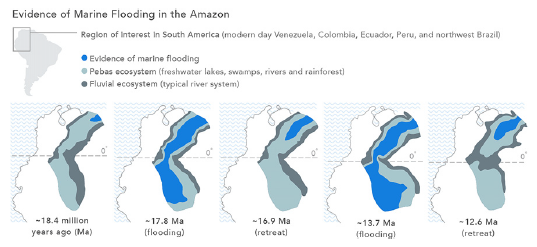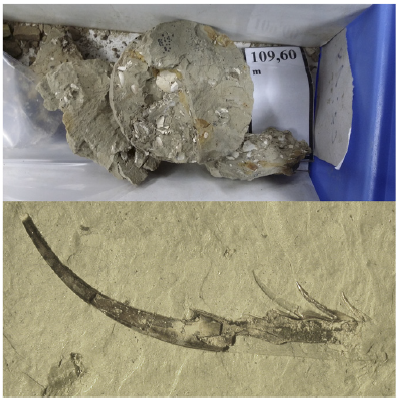Por considerarlo de interés para nuestros lectores reproducimos el artículo A sea in the Amazon. Did the Caribbean sweep into the western Amazon millions of years ago, shaping the region's rich biodiversity? de Amy McDermott, periodista científica de PNAS, publicado el 3 de marzo de 2021, en la sección "Noticias" del PNAS.
Gene Russo, editor de Front Matter Section, dió el permiso correspondiente para la reproducción. La referencia del comentario original es PNAS 2021 Vol. 118No.10 e2102396118, en https://doi.org/10.1073/pnas.2102396118
A tropical strub called Chrysobalanus icaco pushes up through Brazil´s white sandy beaches. The plant's le thery oval leaves and tough silver bark give it the distancit appearance of a mangrove species, adapted to a life buffeted by saltwater. Strangely, though, C. ¡caco also turns up more than a thousand miles inland, in the forests of the western Amazon. "We find fossil mangroves and associated coastal plants in the middle of the Amazon," says paleoecologist Carina Hoorn, at the University of Amsterdam in The Nedterlands.
The shrub's appearance inland with an assemblage of mangrove plants, noted in a 2019 article, is among the latest lines of evidence hinting that the Caribbean Sea flooded into the western Amazon during the Miocene, sometime in the last 10 to 20 million years 1. If it did, the region could have been awash in shallow saltwater for hundreds of thousands of years after the flooding. C. ¡caco and other plants may have spread into Brazil's interior by dispersing along this sea's beaches, before the water retreated and forest reclaimed the land 2.

New evidence, including geophysical modeling, supports the contentious notion that the Caribbean flooded into the western Amazon during the Miocene. Image credit: Tacio Cordeiro Bicudo (University of São Paulo, São Paulo, Brazil), Victor Sacek (University of São Paulo, São Paulo, Brazil), and Lucy Reading-Ikkanda (artist).

Carina Hoorn uses a hammer and chisel to sample layers rich in organic matter along the Agua Negra outcrop, Colombia, in 1988. Her field assistant, Anibal Matapi, stands at the ladder's base. Black layers of claystone and lignite show forestandswamp taxa, butHoorn didnotfindevidenceofmarineinfluenceatthis site. Image credit: Rien Corstanje (photographer).
The prevailing view of the western Amazon during the Miocene is one of a massive wetland, twice the size of Texas, furred with rainforest and streaked with lakes and tributaries. Whether this wetland was ever inundated byseawater remains a matter of some debate amongst geologists, paleontologists, ecologists, biogeographers, and researchers of pollen known as palynologists. All of them are united by the desire to answer a much larger question: How did the Amazon become so species-rich? That question, Hoorn says, is the "overarching motive that brings us all together."
Several recent studies bolster the case that the Caribbean swept inland. A 2017 analysis of rock cores from Colombia and Brazil, for example, revealed changes in sediments as well as uncovering a fossilized shark tooth and a marine mantis shrimp, consistent with two separate Caribbean flooding periods in the last 20 million years 3. If an inland sea did reach the western Amazon, the changing landscape would have shaped patterns of species dispersal and ultimately diversification. Other lines of evidence, including the occurrence of Amazon River dolphins, sharks, stingrays, and manatees, also suggest that the area was once inundated by saltwater 4.
A series of new geophysical models provide some explanation for how the flooding might have occurred, suggesting a combination of global sea level rise, uplift of the Andes Mountains, and changes in plate tectonics and mantle dynamics. All of these factors would have worked in concert to pull down on the Earth's crust and form a flooded depression in the continent. To find out whether this really happened, geologists will begin the largest sampling project to date, likely this summer, drilling rock cores from three Brazilian sites in search of definitive evidence.
A Lush History
No one really knows what the view would have been, standing on a summit of the Andes Mountains about 20millionyearsago.Fromapeakinmodern-dayPeru, looking north and east, some researchers imagine they'd have seen a glittering inland ocean, "where you could go from Paraguay to Venezuela in a boat," says palynologist Carlos Jaramillo at the Smithsonian Tropical Research Institute, in Panama City, Panama. Still others picture a landscape of freshwater marshes, he says, with "no marine evidence at all."
For his part, Jaramillo envisions multiple intervals during the Miocene when the ocean surged into the western Amazon, creating a continuous inland sea. Saltwater currents would have poured in from the Caribbean in the north, where they mixed with fresh water pouring down from torrential rains. Flooding periods would have been relatively brief, however. For the majority of the epoch, the ocean receded, leaving a freshwater mega wetland of interconnected lakes and snaking channels with a narrow neck to the Caribbean in the north.
The salinity would have been low, because the wetland was mostly freshwater, but episodically salty, says paleontologist Frank Wesselingh. He's spent two decades studying the ancient western Amazon and is now part of the Netherlands' Naturalis Biodiversity Center in Leiden. Beneath the water's surface, Wesselingh imagines a carnival of colorful fish, as well as stingrays, manatees, and dolphins. Even typically bland mud snails may have been striking, Wesselingh says, based on evidence of squiggled lines and shell ornamentation on 19-million-year-old aquatic snail fossils in the area 5. "I'd love to go snorkeling," he says, "buttherewerealso14-meter-longcaimansand 11-meter-long gharials. There were all kinds of not-so-nice creatures that would be a problem for us."
Such swirling visions of mangroves and salty, brackish water are relatively new for the Amazon. When Hoorn began her PhD fieldwork in 1988, collecting sediment and pollen samples in the Colombian, Peruvian, and Brazilian Amazon, the origins of Amazonian biodiversity were hotly debated. Most biologists at the time focused on the region's more recent history, just the last 2.6 million years, to explain the evolution of biodiversity there. They thought that forest and savannah expanded and contracted between glacial periods, bounded by stable rivers that flowed along the same paths for millennia. Geologist and ornithologist Jürgen Haffer first proposed that theory in 1969, at a time when most biologists thought new species only arose through geographic isolation 6. Haffer assumed a patchwork of isolated refuges of forest and savannah, each an evolutionary haven 7. His ideas dominated the field through the 1980s.

The Caribbean may have swept south twice during the Miocene, penetrating a landscape dominated by freshwater lakes, swamps, rivers, and rainforest. Image credit: Carlos Jaramillo (Smithsonian Tropical Research Institute, Panama City, Panama) and Lucy Reading-Ikkanda (artist).
But by the time Hoorn came along, cracks had appeared in Haffer's theory, and disagreements over his views had become "quite personal," Hoorn recalls. Ultimately, in the early 1990s, a variety of studies refuted Haffer's view, including work on pollen which revealed a recent history of continuous forest cover rather than patchy tree stands 8. Without patchy forest, a theory of geographic isolation didn'thold up. Paleoecologists went back to the drawing board to figure out what had driven Amazonian diversification.
Although Hoorn was aware of the debate raging all around her, "I felt like I had nothing to do with it," she says, because her research focused on the Amazon's much deeper past than the last 2.6 million years. "I lived happily like that," she says with a chuckle. Butin her fieldwork collecting clay and soil samples around the top of South America, Hoorn discovered evidence of fossilized pollen from mangrove trees. She published a seminal study in 1993 suggesting that the pollen was evidence of a megawetland in western Amazonia during the Miocene, 10 to 20 million years ago, which was subject to coastal influence through several periods of marine flooding 9. Shortly after Hoorn finished her doctorate, she took a break from research. Upon her return to Europe in 1999, she was " very surprised" to find that her thesis had exploded across the Amazonian research community.
Whereas Hoorn's Miocene wetland theory has largely been accepted since 1993, according to palynologist Jaramillo, the marine flooding aspect has remained more controversial-in part because of the difficulty of fieldwork in the Amazon, he says. The forest is so dense that geologists tend to travel by riverboat rather than overland, searching for the relatively few exposed rock faces that poke out from under the thick cover of vegetation. Research teams collect sediment samples from the cliffs along the riverbanks. But the cliffs jut out at odd angles, making it difficult to tell whether two outcropping rock faces are the same age based on stratified rock layers alone. Some show evidence of marine influence. Fossilized mollusks and ostracods stud certain cliffs, and oxygen-and carbon-stable isotope ratios in some samples also point to saltwater flooding 10.
But not all riverbank sediments tell the same story, and none is unequivocally marine. Even among those that support marine influence, there are seeming contradictions. In a study Wesselingh published in 2006, for instance, he found fossilized saltwater invertebrates alongside freshwater mollusks in the same rocky outcrop. He concluded that the fossils could be different ages. Or, if they were the same age, the saltwater invertebrates could have evolved an unusual tolerance for freshwater 11. Without limestone deposits or fossilized whale skeletons-the kind of material that plainly shows areas once under oceans in other parts of the world-the debate over the Amazon rages on.
Shifting Tides
Jaramillo himself was skeptical of an Amazonian sea until about three years ago. Fossil-strewn rock cores changed his mind. Stored in the laboratory of Paleo-flora in Bucaramanga, Colombia, each core is a cylinder of shale, clay, and sandstone, drilled out of sites in northern Brazil or Southern Colombia. The Brazilian geological survey and a Colombian oil company had collected them in the 1970s, in search of coal and oil. And although the cores were old and in some cases broken or incomplete, they offered the best available window on the past, Jaramillo says.
With a hand lens pressed to his eye, Jaramillo scanned each core, inspecting the many different layers of sediment, deposited one on top of the other over millions of years. Some of the layers were unmistakably river mud, with the kinds of fine-grained sediments, sandstones, and mudstones that tend to accumulate in tributaries today. But two of the layers were more typically marine. Organic peat, algae, and fossil fragments hinted at salty estuarine environments. Under a microscope, the fossils included about 20 different species of dinoflagellates found in Miocene marine deposits worldwide. Two larger fossils, a shark tooth and a marine mantis shrimp, provided further evidence for ocean flooding. Pollen records from the two marine sediment layers suggest that they date to 18 million years ago and 14 million years ago, respectively.

In a 2017 study, Carlos Jaramillo and coauthors analyzed rock cores from Columbia and Brazil (top) consistent with two separate Caribbean flooding periods in the last 20 million years. Evidence included this marine mantis shrimp (bottom). Image credit: Carlos Jaramillo (Smithsonian Tropical Research Institute, Panama City, Panama).
"The logical conclusion is the ocean was there," Jaramillo explains. His 2017 analysis of the cores demonstrated two marine intervals when ocean waters reached the western Amazon, he says, with the incursion likely starting from the Caribbean in the north and flowing south along the foot of the Andes (3). In each case, the water advanced and then retreated over periods as short as halfa million years. Jaramillo suspects that a combination of tectonic processes and punctuated global sea level rise flooded a depression in the continent. Geological models published since 2010 suggest such a scenario is possible 12.
High-speed video simulations show the uplift of the Andean cordillera over tens of millions of years and, in some cases, the subsequent submersion of western Amazonia. Over a Zoom call from his office at the University of São Paulo, Brazil, geophysicist Victor Sacek screen-shared one such model, which he first developed in 2014. It simulates the surface of South America during the uplift of the Andes, beginning sometime between 30 million and 60 million years ago. The initial model described geological processes at the level of Earth's crust, such as erosion, sedimentation, and the formation of the Andean Cordillera. In 2019, PhD student Tacio Cordeiro Bicudo updated the model to also approximate processes deep in the Earth, including convection in the mantle below the South American continent.
To picture mantle convection, Sacek says, first imagine the western edge of South America colliding with the oceanic Nazca Plate tens of millions of years ago. As the two tectonic plates ground against each other, the lip of South America contracted and thickened into the rising spine of the Andes. Simultaneously, the oceanic Nazca Plate dove under the continent into the softer mantle beneath it. Think of the hard, dense oceanic plate as if it was made of iron, Sacek says, and the mantle as a vat of honey. The heavy iron mass plunging through the honey would create convection that perturbed the liquid's surface. So, too, did the plate sinking through the mantle, creating a smooth depression in the Earth's surface far above. When Sacek, Bicudo, and others included these dynamics in their models-published in 2019 and 2020-the simulations put this subsidence right under the western Amazon, forming a huge depression in the continent 13,14. This hollow could have flooded from the Caribbean, pouring in across an apron-shaped expanse of what is now parts of Colombia, Ecuador, Bolivia, Peru, and western Brazil, to form an inland sea between 25 and 17 million years ago.
Whether this actually happened is still impossible to say. "With our models we just give scenarios," Bicudo says. The mantle was certainly in motion beneath the continent at the time, he says. But the size and shape of the depression itcreated, and whetherit ever connected to the ocean, remain unknown. Geodynamicist Nicolas Flament at the University of Wollongong in Australia has also modeled the western Amazon. In one 2015 paper, he combined data on the positions and speed of the tectonic plates and the thickness of the top layer of the mantle, called the lithosphere, to simulate the changing topography of South America attributable to mantle convection over the last 50 million years 15. Flament's models also predicted a western Amazonian shallow sea during the Miocene. Although he acknowledges that "models are not evidence," Flament thinks the fact that his tectonic data-based simulations match predictions from the geological record lends further support to marine incursions as plausible-even likely.
Ebb and Flow
A sea in the Amazon captures the imagination, but there are still geologists who consider it just that- imaginary. What's clear in the geological record is that mud, silt, and, in smaller proportion, sand blanketed the region, explains Edgardo Latrubesse, at the Federal University of Goias in Goiania, Brazil. The age of those sediments, and how exactly they arrived in the western Amazon, is less clear. Oceans don't typically transport and deposit sediment into vast inland areas, Latrubesse points out. Rivers, on the other hand, do erode mountains and hills to produce sandy and silty deposits. "To accumulate such a huge amount of sediment, the only way are rivers," Latrubesse says. Hoorn and Jaramillo, in fact, would agree that although repeated ocean flooding carried some sediments, most did wash in on rivers when the area looked more like a freshwater wetland than a continuous sea.
One key point of disagreement: the age of the sediments. Fossil pollen, ostracod, and mollusk assemblages date them to mid-to-late Miocene, which would match the proposed age of the ancient sea. But Latrubesse doesn't put much stock in pollen-based age estimates; plants, he says, evolve too slowly to provide precise-enough date ranges. And in work published in 2010 analyzing vertebrate fossils from the southwestern Amazon, Latrubesse dated the sediments as far more recent, 6.5 to 9 million years old 16. It makes no sense to debate the existence of an inland sea 20 million years ago, he says, based on evidence from sediments that aren't even 10 million years old.
In other parts of the world, layers of volcanic ash could be used for absolute radiometric dating. But volcanic ash sediments are rare in the western Amazon. Geologists instead rely on comparisons of fossils with the evolutionary record, which is far from an exact science, says palynologist Andrea Kern. She coauthored a 2020 study aiming to resolve the Amazon sediment age debate while working as a postdoc at the University of São Paulo in Brazil. Kern and her collaborators analyzed one Brazilian sediment core from a different site in the same collection that Jaramillo used in his 2017 analysis. In previous studies, pollen and ostracod fossils had dated the rock to the middle Miocene, about 14 million years ago. However, Kern's 2020 study used grains of the mineral zircon buried in the sediments alongside the fossils 17. Zircon can be radio metrically dated, and Kern's analysis put the rock's maximum age at about 11.4 million years. Although the coresin both studies came from sites potentially inundated by marine incursions during the Miocene, most of the pollen and ostracod fauna in the sample Kern analyzed indicated swamps and small lakes transitioning to a river-dominated habitat. She acknowledges, however, that it is just one record from a single site.
Drilling Down
"I love this stuff, but it's so complicated," says evolutionary biologist John Bates, speaking from the Field Museum in Chicago, IL, where he curates birds. Although geology isn't his specialty, Bates is keenly interested in the geologic history of the western Amazon. "I want to know what the ramifications were for biology," he says. An inland sea could help explain how a region that contains a tenth of the world's known species became such a trove of life.
Take, for instance, the sand-colored nighthawk. The bird is only found in the western Amazon, where it nests on sandbanks. There's no clear behavioral or ecological reason why nighthawks should be tied to creeks and rivers, Bates says. Yet they are, as are scarlet-crowned barbets and a wealth of other birds, endemic to the same waterways.
A massive Miocene lake or sea could offer some evolutionary explanation for the birds' association with a shoreline niche, Bates says. He coauthored a 2018 study comparing the phylogenetic relatedness and geographic distributions of 1,783 passerine species across 19 families of neotropical birds 18. Bates found that bird lineages in the western Amazon are younger and more related, on average, than lineages in surrounding areas. That means the western Amazon has its own evolutionary history, separate from the rest of the continent, he says. A huge body of water would have been such a starkly different habitat from surrounding forests that it could have spurred a unique evolutionary signature among species there. If sand-colored nighthawks evolved around an ancient sea or delta, it may explain why they still live near water today.
Plant species, too, could have been affected by marine incursions. Although the Amazonian flora was diverse millions of years before the Miocene, Hoorn notes that saltwater flooding could certainly have altered regional plant biodiversity. Not only would seawater change the chemical composition and fertility of the soil, shaping which plants grew where, but coastal species brought inland by marine incursions could also have been isolated and adapted into new groups. If a seaway enabled new plants and animals to radiate into the west, it could be an overlooked mechanism driving the region's species richness.
Geologists agree that resolving exactly what the Miocene landscape looked like will require better rock samples. The oil and coal industries did not collect cores with multidisciplinary studies in mind; some are contaminated and so can't be thoroughly analyzed by researchers. They're also proprietary and only available to a small subset of the scientific community.
"I'd say it's pretty much a slam dunk that there were marine incursions in South America. It's just all of the details are difficult."
-Christine Bacon
Paul Baker, a geologist at Duke University in Durham, NC, will colead the effort, likely starting in June or July, to collect and analyze what researchers believe will be the best sediment samples ever taken from the Amazon. Called the Trans-Amazon Drilling Project, and funded by the National Science Foundation, International Ocean Discovery Program, the São Paulo Research Foundation, and the Smithsonian Institution, the plan includes roughly 50 scientific collaborators from a range of disciplines, including Hoorn and Jaramillo. They will drill 2,000-meter-long sediment cores from three Brazilian sites running east-to-west across the Amazon Basin, following the Amazon River, with the goal of capturing a sn apshot of the entire Cenozoic Era, from 66 million years ago to the present 19. Painstakingly collected and carefully stored, these freshly drilled cores will capture even millimeter-scale changes in the sediment layers that could hold evidence of ocean incursion. Continuous rock will give geologists their best shot yet at comprehensively assessing every layer of Miocene sediment for marine evidence. And dating zircon grains in the rock cores will give the most definitive time frame for the sediment to date, based on "by far the best material that's ever been looked at," Baker says.
"I'd say it's pretty much a slam dunk that there were marine incursions in South America," says evolutionary biologist Christine Bacon, co-first author of the 2019 study on C. ¡caco and other plants' unusual inland distributions. "It's just all of the details are difficult," she says, on the phone from the University of Gothenburg in Sweden. If there is unequivocal marine evidence, its hould turn up in the new cores. "Without continuous rock," Jaramillo says, "the discussions could go forever. " And that might mean never knowing whether the view from the Andes 20 million years ago included a vast, shimmering inland sea.














